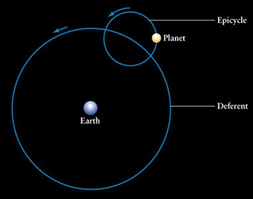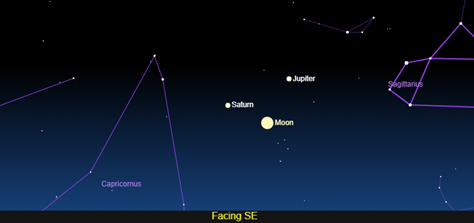This year is a special one for stargazers. For only the third time since I have been a stargazer, the two largest planets, Jupiter and Saturn, are drawing together in the sky. Of course, they are stable in their orbits and are not really physically much closer to the each other than normal- it is just the viewpoint that we see them from aboard spaceship Earth. Being much farther from the Sun than we are, Jupiter takes nearly twelve of our years and Saturn almost thirty to complete one orbit around our star. So I will be turning two in Saturnian and five in Jovian years in the near future- a celestial fountain of youth! As seen from Earth, Jupiter appears to pass Saturn every twenty years- an event astronomers have termed a Great Conjunction. 2020 is the year!
You might think that if one watched the two planets all year, you would see Jupiter steadily close in on Saturn until it finally caught up, but that neglects the motion of the Earth around the Sun. If you imagine a faster car racing a slower car around the track, when the faster car passes the slower, the slower car appears to move backwards from the viewpoint of the driver of the fast car. Similarly, if you had been watching Jupiter and Saturn relative to the background stars earlier this year, you would have seen them move steadily eastward and then slow down, become stationary, and reverse course for a few months! In the second century A.D., mathematician Claudius Ptolemy noticed this. Believing that the planets and Sun revolve around the Earth, he devised a system of epicycles- basically small loops in their orbits- to explain this phenomenon of retrograde motion. Ptolemy’s model explained the motion fairly well and prevailed for about 1400 years. Finally, Copernicus’ theory of a Sun-centered solar system, backed up by the mathematical laws of Kepler and Newton, rendered the ancient system obsolete.
 Claudius Ptolemy (2nd century A.D.)
Claudius Ptolemy (2nd century A.D.) 
The small circular path is called the epicycle, and the planet somehow followed it while orbiting the Earth (the deferent) at the same time. Courtesy Earth, Sea, Sky.

Facing southeast, 11 PM, July 5. The almost Full Moon will make an impressive triangle with Jupiter and Venus. On the previous evening, the Fourth of July, the Full Moon will be to the right of the two planets. On that night, around 11:30 pm, can you notice an extremely slight shading on the upper part of the Moon? Try with binoculars. The Moon is just grazing the outer edge of the Earth’s shadow in a Penumbral eclipse, but it is so slight it may not be noticeable. (Sky & Telescope)
At the start of July the two giant planets rise in the southeastern sky around 10 pm. Saturn shines with a dull yellowish hue about as bright as the brighter stars in the sky, while Jupiter is eleven times brighter. They appear about 5° apart, or roughly the width of your three middle fingers as seen at arm’s length. By the end of July, the two planets rise before sunset and are visible all night. Due to Jupiter’s faster retrograde motion, it will appear as far as 8° from Saturn by the beginning of September. Then Jupiter will finally overtake Saturn. On December 21, low in the southwestern sky after sunset, the two will appear just 0.1° apart. This spacing is just one fifth the apparent size of the Full Moon! This year’s Great Conjunction might be the best one to see between 1800 and 2100. Those who get up early on the morning of March 15, 2080 will see Jupiter and Saturn separated a similar distance to this year, but I don’t think that my alarm clock will wake me.
If all of this weren’t enough, there is a chance of a pretty bright comet this month. Keep an eye on reliable media for updates on Comet NEOWISE. Discovered on March 27, it will pass closest to the Sun on July 3 and to the Earth three weeks later. Comets are extremely unpredictable in their behavior- often ending up much fainter than expected or even succumbing to the heat of the Sun. Comets ATLAS and SWAN were both expected to put on a decent show this spring, but are now resting in pieces. I plan to post updates on the GatewayArchNPS Facebook page on Comet NEOWISE’s progress or lack thereof.
